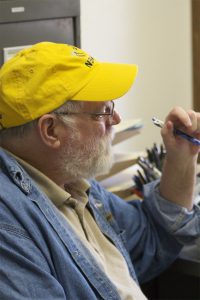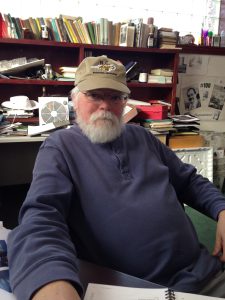The American Glass Guild
by Scott Ouderkirk
Bees – We hear so much about them lately, but most people still aren’t aware how much work bees do around them each day. Honey bees are constantly flying above us, back and forth on their business, unseen and unsung. My friend, Marty Snye, is a blacksmith and beekeeper, and I am a glass artist and beekeeper. We often work together on hives and other projects, but our love of bees caused us to truly collaborate for the first time on this piece called The Queen.
My name is Scott Ouderkirk, and I am lucky enough to live in the Thousand Islands, which is a section of the St. Lawrence River on the border of New York State and Canada. I do most of my work alone in my studio overlooking the river, so I don’t often have to answer to anyone about my art…until my wife tells me something needs to be changed. Working together on a project with another artist isn’t something that I am used to; but Marty and I had been talking about creating some work together so that we could have a show of collaborative pieces using my glass work framed by his iron work. I had created a small bee piece for an illustration in my book, The Wind in the Islands, which Marty had framed with iron. We thought, why not scale this piece up to make a more powerful statement? Thus, I began sketching some ideas.
At about the same time, a call for entries for the American Glass Guild’s 2015 exhibit in the National Cathedral in Washington DC arrived. We decided to enter this piece. The next thing you know, our entry was accepted, and we got to work.
My first drawings were fairly simple following the small original. I showed the drawing to Lorraine Austin, who is a glassblower and my go-to person for design help. Her ideas made the design much more organic and complicated. She also created the glass ball which sits at the top of the piece. Marty made a few changes to the full size drawing; then he built the frame. The frame is made of steel which is heated and hammered into shape. Marty works with very traditional methods; only using more contemporary methods when appropriate. In this case, it was easier for me to create glass pieces to match the frame rather than the other way around.
Once I had Marty’s finished frame in my studio, I began creating fused glass pieces which would fit into the frame sections. As many as eight layers of colored and clear glass were stacked up and fused together. I included in the painting a selection of flowers and plants which honey bees visit during their busy lives. The small bees are painted on the back of the glass to create depth. The technique of glass painting used on The Queen consists of adding black and brown outlines and shading to colored fused glass. The image of the glass pieces on the light table shows the glass before the final firing. In the final firing, the glass was silver stained, which involves applying a silver compound to the back of the glass and firing it. This causes a yellow staining of the glass and is where stained glass gets its name. The silver staining was not added to the wing areas, allowing them to remain clear.
The Queen lived in the National Cathedral in Washington, DC until July 31, 2015. We hope that it made the many visitors to the cathedral think about honey bees and how they help all of us. It is a partnership that more people need to be aware of. The plight of the bees should be taken into consideration when environmental decisions are made because it is our plight as well.
It is important for an artist to step out of his or her comfort zone occasionally. Every collaboration leads to new ideas and growth for all parties involved. A person who is unfamiliar with a process may ask for something to be done which needs new techniques to be learned or even developed. Marty and I find this to be true whether we are working as artists or beekeepers; and this project was no exception. Fortunately, as I grow older, I find my thirst for knowledge continues to increase.






